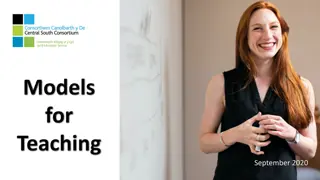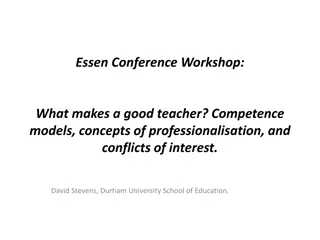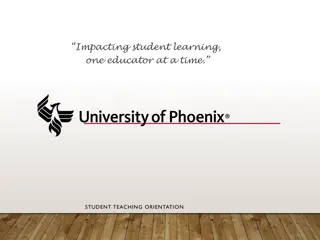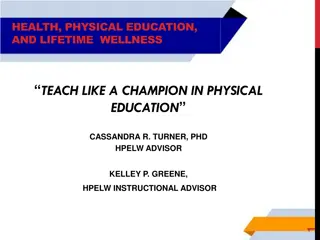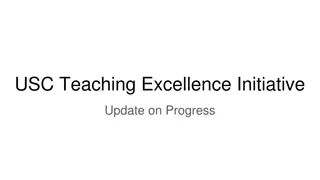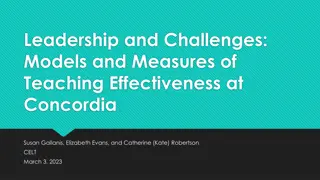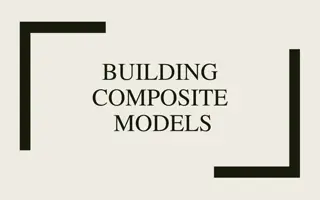Understanding Models of Teaching in Education
Exploring different models of teaching, such as Carroll's model, Proctor's model, and others, that guide educational activities and environments. These models specify learning outcomes, environmental conditions, performance criteria, and more to shape effective teaching practices. Functions of teaching models include guiding teachers in selecting techniques, creating favorable environments, and fostering teacher-pupil interaction. Learn about the characteristics and significance of these models in enhancing the teaching-learning process.
Download Presentation

Please find below an Image/Link to download the presentation.
The content on the website is provided AS IS for your information and personal use only. It may not be sold, licensed, or shared on other websites without obtaining consent from the author. Download presentation by click this link. If you encounter any issues during the download, it is possible that the publisher has removed the file from their server.
E N D
Presentation Transcript
DR. SANTHAKUMARI PRINCIPAL DHANALAKSHMI SRINIVASAN COLLEGE OF EDUCATION PERAMBALUR
DEFINITION OF MODELS OF TEACHING Allen and Ryan (1969); Modeling is an individual demonstrating particular pattern which the trainee through imitation. B. K. Passi L. C. Singh and D. N. Sansanwal (1991); A model of teaching consist of guidelines for designing educational activities and environments. Model of teaching is a plan that can also be utilized to shape courses of studies, to design instructional material and to guide instruction.
MAIN CHARACTERISTICS OF TEACHING MODEL Specification of learning outcomes; A models of teaching specify what the students should perform after completing an instructional sequence. 2. Specification on environment; A models of teaching specifies in definite terms the environmental condition under which a student s response should be observed. 3. Specification of criterion of performance; A models of teaching specifies the criterion for performance which is expected from the students. 4. Specification of operation; A models of teaching specifies the mechanism that provides for the reaction of students and interaction with the environment. 5. Scientific procedure; A models of teaching is based on a systematic procedure to modify the behavior of the learner. It is not a haphazard combination of facts.
FUNCTIONS OF TEACHING MODELS guiding the teacher to select appropriate teaching techniques, strategies and methods for the effective utilization of the teaching situation and material for realizing the objectives. bringing about desirable changes in the behaviour of the learners. finding out ways and means of creating favorable environmental situation for carrying out teaching process. achieving desirable teacher-pupil interaction during teaching. the construction of a curriculum or contents of a course. proper selection of instruction material for teaching the prepared course or the curriculum. designing appropriate educational activities. assist procedure of material to create interesting and effective materials and learning sources. stimulate the development of new educational innovations. formation of theory of teaching.
MODELS OF TEACHING JOHN CARROLL'S MODEL PROCTOR'S MODEL CRUICKSHANK'S MODEL GAGE AND BERLINER'S MODEL HUITT'S MODEL
JOHN CARROLL'S MODEL Carroll specialized in language and learning, relating meanings to the cognitive concepts and constructs which (Klausmeier & Goodwin, 1971). In his model, Carroll states that time is the most important variable learning. A simple Carroll's model is: School Learning = f(time spent/time needed). words and their they create to school equation for
continue Carroll (1963) proposed that the time needed by students to learn academic content is contingent upon aptitude (the most often used measure is IQ), ability to understand the instruction presented (the extent to which they knowledge),and the quality of instruction students receive in the process of learning. Carroll proposed that these specific teacher and student behaviors and student characteristics where the only variables needed to predict school learning; he did not include the influences of family,community,society possessed prerequisite
PROCTOR'S MODEL Proctor (1984) provides a model that updates this view by including important teacher and student behaviors as predictors of student achievement. It is derived from other teacher- and classroom-based models but is redesigned to emphasize teacher expectations. Proctor states that it is possible for a self-fulfilling prophesy (as researched by Rosenthal & Jacobson, 1968) to be an institutional phenomenon and the climate of a school can have an effect on the achievement of its learners. The attitudes, the norms, and the values of an educational faculty and staff can make a difference in achievement test scores. a.The paradigm most influencing Proctor's model is that of a social nature and not of a teacher/student one-on-one relationship.The other models include the variables that provide the focus for this model, but show these variables in a more subordinate manner.
b. Proctor's (1984) model begins with the factor of the School's Social Climate. Some of the variables included in this would be attitudes, norms, beliefs, and prejudices. This school climate is influenced by a number of factors, including characteristics as race, gender, economic level, and past academic performance. The student characteristics also influence teacher attitudes and teacher efficacy. such student
The interactions in Proctor's (1984) model c. The interactions in Proctor's (1984) model include the school's overall policy on allowing time for children to learn or promoting other forms of student-based help when needed. This could include instruction (as in Carroll's (1963) model above) or teacher behaviors (as in model ). These behaviors have an effect on student classroom performance (especially academic learning time and curriculum coverage) and self-expectations . quality of classroom (1985) Cruickshank's
d. student's achievement level in Proctor's (1984) model is an outcome of all previous factors and variables. It is hypothesized that there is a cyclical relationship among the variables. In Proctor's model, the main concept is that achievement in a specific classroom during a particular school year is not an end in itself. It is refiltered into the social climate of the school image and the entire process begins all over again. Proctor's model implies that change can be made at any point along the way. These changes will affect school achievement, which will continue to affect the social climate of the school.
CRUICKSHANK'S MODEL The model by Cruickshank (1985) is more classroom- and teacher-based; he was heavily influenced by models created by Mitzel,Biddle,and Flanders. a. Mitzel contributed the concept of classifying variables as "product,process,or presage" . Product is learning on the part of the student (change in behavior or behavior potential) while process involves interaction between student and teacher. Presage is the teacher's intelligence, level of experience, success and other teacher characteristics. Presage is supposed to affect process and then,of course, process will affect the product
b. Biddle (as cited in Biddle & Ellena, 1964) showed a relationship between specific learning activities and teacher effects. In his model, Biddle offers seven categories of variables related to schooling and student achievement: school and community contents, formative experiences, classroom situations, teacher properties, teacher behaviors, intermediate effects, and long-term consequences. This foundation for Cruickshank's (1985) model. provides the
c. Flanders (as cited in Cruickshank, 1985) offered the variables of teacher- and student-classroom-talk and devised an instrument which focused on this behavior. "His was the most frequently used instrument. It permitted observation of teachers' use of 'verbal influence,' defined as 'teacher talk' and 'pupil talk,' in a variety of classroom situations" . Cruickshank put them all together and added additional presage variables such as pupil characteristics,properties (abilities and attitudes) and school, community and classroom climate
GAGE AND BERLINER'S MODEL Gage and Berliner (1992) developed a model of the instructional process that focuses on those variables that must be considered by the classroom teacher as she designs and delivers instruction to students. This model attempts to define more precisely what is meant by "quality instruction" and presents five tasks associated with the instruction/learning process. The model is classroom- and teacher-based and centers around the question,"What does a teacher do?" A teacher begins with an evaluation. Instruction connects objectives and evaluations and is based on the teacher's knowledge of the students' characteristics and how best to motivate them. If the evaluations do not demonstrate that the desired results have been achieved, the teacher re-teaches the material and starts the process all over again. Classroom management is subsumed under the rubric of motivating students. Gage and Berliner suggest that the teacher should use research and principles from educational psychology to develop proper teaching procedures to obtain optimal results. objectives and ends with
HUITT'S MODEL The most recently developed model to be discussed (Huitt, 1995) identifies the major categories of variables that have been related to school achievement. The model is not only school-, classroom-, teacher-, and student-based, but includes additional contextual influences as well One important addition in this model is the redefinition of Academic Learning Time .
Huitt advocates that important context variables must be considered because our society is rapidly changing from an agricultural/industrial base to an information base. From this perspective, children are members of a multi-faceted society, which influences and modifies the way they process learning as well as defines the important knowledge and skills that must be acquired to be successful in that society. Huitt's model shows a relationship among the categories of Context (family, home, school, and community environments), Input (what students and teachers bring to the classroom process), Classroom Processes classroom),and Output (measures of learning done outside of the classroom). These categories appear superimposed in the model since it is proposed they are essentially intertwined in the learning process The most direct impact on important measures of school learning are those variables related to Classroom Processes. This category includes two major subcategories (Teacher Behavior and Student Behavior), and an Other (or miscellaneous) subcategory that includes such variables as classroom climate and student leadership roles.. (what is going on in the
Huitt proposes that these three components of Academic Learning Time should be considered as the "vital signs" of a classroom. Just as a physician looks at data regarding temperature, weight, and blood pressure before asking any further questions or gathering any other data, supervisors need to look at the content overlap, involvement, and success before collecting any other data or making suggestions about classroom modifications. Classrooms where students are involved and making adequate progress on important content are reasonably healthy and quite different from those classrooms where students are not. In addition to the teacher's classroom behavior, other time components such as the number of days available for going to school (the school year), the number of days the student actually attends school (attendance year), and the number of hours the student has available to go to school each day (school day) can influence ALT (Caldwell et al., 1982). None of these additional time variables were included in Carroll's (1963) model.
The size and region of the community combine with family characteristics and processes to impact teacher and student characteristics. School and state policies combine with teacher and student characteristics to impact teacher behavior, while student behavior influence student behavior. Student classroom behavior then influences teacher classroom behavior in an interactive pattern that eventually results in student achievement as measured by instruments influenced by state policies. Student achievement at the end of one school year then becomes a student characteristic at the beginning of the next. characteristics and teacher
Models are useful tools to better understand not only the learning processes of students, but ourselves as educators. At a glance the models might provide only more questions, but a careful study of the models can provide starting points to begin developing more appropriate educational experiences for our society's next generation THANK YOU















